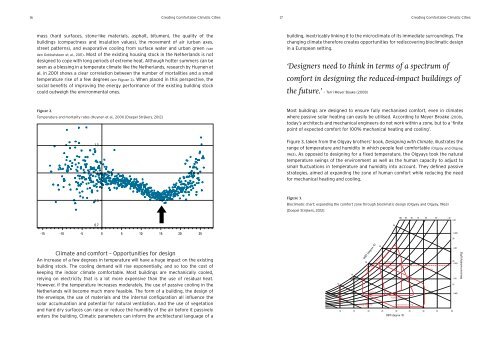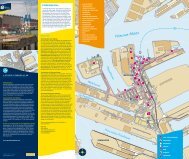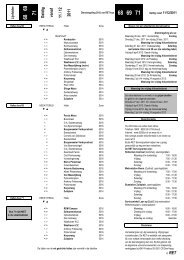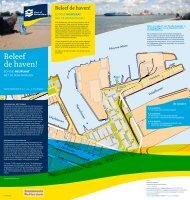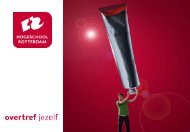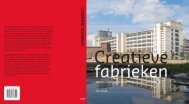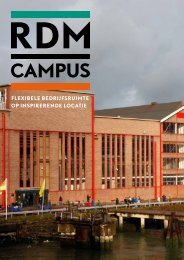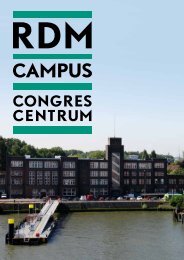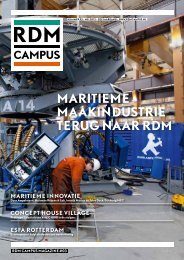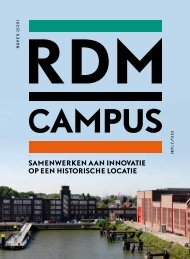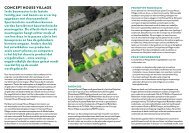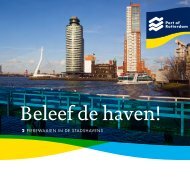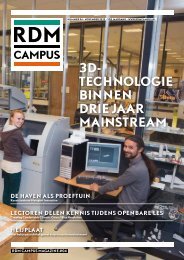16 <strong>Creating</strong> <strong>Comfortable</strong> <strong>Climatic</strong> <strong>Cities</strong>17<strong>Creating</strong> <strong>Comfortable</strong> <strong>Climatic</strong> <strong>Cities</strong>mass (hard surfaces, stone-like materials, asphalt, bitumen), the quality of thebuildings (compactness and insulation values), the movement of air (urban axes,street patterns), and evaporative cooling from surface water and urban green (vanden Dobbelsteen et al., 2011). Most of the existing housing stock in the Netherlands is notdesigned to cope with long periods of extreme heat. Although hotter summers can beseen as a blessing in a temperate climate like the Netherlands, research by Huynen etal. in 2001 shows a clear correlation between the number of mortalities and a smalltemperature rise of a few degrees (see Figure 2). When placed in this perspective, thesocial benefits of improving the energy performance of the existing building stockcould outweigh the environmental ones.building, inextricably linking it to the microclimate of its immediate surroundings. Thechanging climate therefore creates opportunities for rediscovering bioclimatic designin a European setting.‘Designers need to think in terms of a spectrum ofcomfort in designing the reduced-impact buildings ofthe future.’ – Terri Meyer Boake (2008)Figure 2.TEMPERATURE AND MORTALITY RATESTemperature and mortality rates (Huynen et al., 2001) [Doepel Strijkers, 2012]Most buildings are designed to ensure fully mechanised comfort, even in climateswhere passive solar heating can easily be utilised. According to Meyer Broake (2008),today’s architects and mechanical engineers do not work within a zone, but to a ‘finitepoint of expected comfort for 100% mechanical heating and cooling’.1.31.1Figure 3, taken from the Olgyay brothers’ book, Designing with Climate, illustrates therange of temperature and humidity in which people feel comfortable (Olgyay and Olgyay,1963). As opposed to designing for a fixed temperature, the Olgyays took the naturaltemperature swings of the environment as well as the human capacity to adjust tosmall fluctuations in temperature and humidity into account. They defined passivestrategies, aimed at expanding the zone of human comfort while reducing the needfor mechanical heating and cooling.0.90.7Figure 3.Bioclimatic chart; expanding the comfort zone through bioclimatic design (Olgyay and Olgyay, 1963)[Doepel Strijkers, 2012]Relative humidity (%)100 90 80 70 60 5040300.03-15 -10 -5 0 5 10 15 20 250.02530SOURCE: HUYEN ET AL, 2001Climate and comfort – Opportunities for designAn increase of a few degrees in temperature will have a huge impact on the existingbuilding stock. The cooling demand will rise exponentially, and so too the cost ofkeeping the indoor climate comfortable. Most buildings are mechanically cooled,relying on electricity that is a lot more expensive than the use of residual heat.However, if the temperature increases moderately, the use of passive cooling in theNetherlands will become much more feasible. The form of a building, the design ofthe envelope, the use of materials and the internal configuration all influence thesolar accumulation and potential for natural ventilation. And the use of vegetationand hard dry surfaces can raise or reduce the humidity of the air before it passivelyenters the building. <strong>Climatic</strong> parameters can inform the architectural language of aWBT (degree o C)20Ventilation1510ComfortWarmingRadiant CoolingIncreasing HumidityEvaporative Cooling101520253035DBT (degree o C)Effect and Capability for Applying Bioclimatic Strategies25Humidity ReductionAirconditioning40450.02200.0150.01100.00550Absolute humidity (g/Kg)
18 <strong>Creating</strong> <strong>Comfortable</strong> <strong>Climatic</strong> <strong>Cities</strong>19<strong>Creating</strong> <strong>Comfortable</strong> <strong>Climatic</strong> <strong>Cities</strong>The Olgyays’ work demonstrates that one must design differently for differentclimatic regions. This may seem obvious, but office buildings or houses look prettymuch the same in temperate and tropical climates around the world. It is logical thatif you need heat for much of the year, you will deal with the sun differently than if youpredominantly need cooling.Designing for the zone implies a dynamic definition of comfort and acceptance ofseasonal and diurnal fluctuations. The work of Phillipe Rahm takes this as a pointof departure for design. In what he terms ‘meteorological architecture’, convection,pressure, radiation, evaporation and conduction are tools for architecturalcomposition. The architectural form explores the atmospheric and poetic potentialof new construction techniques for ventilation, heating, dual-flow air renewal andinsulation (Rahm, 2009; Rahm, 2010). This approach to design embraces climate change asan opportunity to create buildings that are in harmony with the environment and takeoptimal advantage of their specific microclimate (see Image 5 and Figure 4).active, we could have a temperature of 18 ° C. The living room is often 20 ° C because we are dressed withoutmoving, motionless on the sofa. The bathroom is the warmest space in the apartment because here we arenaked. Keeping these precise temperatures in these specific areas could save a lot of energy by reducing thetemperature to our exact needs. Related to these physical and behavioural thermal figures, Rahm proposesshaping the apartment into different depths and heights: the space where we sleep will be lower while thebathroom will be higher. The apartment would become a thermal landscape with different temperatures, inwhich the inhabitant could wander around as if in a natural landscape, looking for specific thermal qualitiesrelated to the season or the moment of the day. By deforming the horizontal slabs of the floors, rooms orspaces are created with different heights and different temperatures. The deformation of the slabs also givesthe building its outward appearance (Rahm, 2009; Rahm, 2010).Figure 4.Functions related to thermal zones. [Philippe Rahm Architects, 2010]Image 5.Convective apartments, Hamburg. {Philippe Rahm Architects, 2010} [Philippe Rahm Architects, 2010]The design of this condominium building is based on the natural law that makes warm air rise and cold airfall. Very often, a real difference in temperature can be measured between the floor of an apartment andthe ceiling, sometimes up to 10 ° C. Depending on our physical activities and the thickness of our clothing, thetemperature does not have to be the same in every room of the apartment. If we are protected by a blanket inbed, the temperature of the bedroom could be reduced to 16 ° C. In the kitchen, if we are dressed and physicallyPeak oilThe biggest social problem is not climate change, but the depletion of our energyreserves, a social economic problem rather than a technical one (Tillie et al., 2009). TheNetherlands is addicted to fossil fuels: 96% of the energy we use is derived from nonrenewablesources making us one of the least sustainable nations in the EuropeanUnion (Daniëls and Kruitwagen, 2010). This can of course be attributed to the abundance ofnatural gas and the investments made in fossil fuel infrastructure over the last halfcentury.But nothing lasts forever. According to research by ECN and NPL (Daniëls andKruitwagen, 2010), our natural gas reserves will be depleted within the next twenty-fiveto thirty years. Peak oil, the point at which we have consumed more than 50% of theworld’s reserves, was reached in September 2008 (see Figure 5). At one point, the priceof oil rose to the unprecedented level of almost 140 dollars per barrel and expertsexpected it to double. Although prices dropped relatively quickly, it is clear that asoil becomes increasingly scarce, prices will continue to rise. Peak oil also means peaksynthetic plastics, as oil is the main raw ingredient for these materials (Faud-Luke, 2009).Exact predictions vary, but experts agree that within seventy-five years, within thelifetime of our children, oil and uranium will be depleted (WNA, 2012; Owen et al., 2010;Appenzeller, 2004).There is a growing awareness that importing energy from other regions should beconsidered in the light of political dependence, ecological impacts, ethical aspectsand, of course, the economic implications (van den Dobbelsteen et al., 2011). Peak oil andpeak plastic present two inherent challenges to mankind: making optimal use of our


